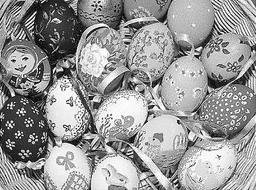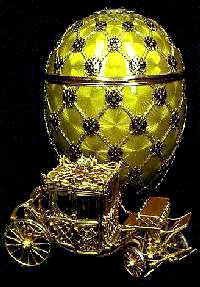Easter La Benedizione delle Uova – Blessing the Eggs
written by David Anderson limited rights reserved ViewItaly.blogspot.com
 My mother in law is from a small town outside of Crema. The Friday before Easter, the families prepare large baskets of boiled eggs. An olive branch is then placed in the center of the basket and off to church. The eggs are blessed in a pompous ceremony and the eggs are then consumed in by the end of Easter Sunday.
My mother in law is from a small town outside of Crema. The Friday before Easter, the families prepare large baskets of boiled eggs. An olive branch is then placed in the center of the basket and off to church. The eggs are blessed in a pompous ceremony and the eggs are then consumed in by the end of Easter Sunday.Have you ever wondered why eggs are part of the Easter tradition?
Eggs represent Easter all across the world and as a symbol they have been subjected to every sort of esthetic manipulation: they are painted, carved, covered; the basic ingredients have changed such as chocolate and sugar. While the plastic or chocolate eggs are very recent, real eggs, colored or golden have their origins deep in the past.
Eggs have always been a symbol of life. Their importance is seen in pre-Christian beliefs that the earth and the sky were two parts of the same egg and many spring rituals included the egg as a sign of rebirth. When the birds would return, prepare their nests, and lay their eggs it was evident that winter, with its cold, had past.
 The Greeks, Chinese and Persians exchanged eggs as part of the spring celebrations, as the Egyptians decorated eggs for the spring equinox, date of their new year, a time when the year was based on seasons. The egg was seen as a miracle not understanding how a new life could be created from such an unusual object. Eggs were considered precious objects with almost magical capabilities. They were buried under the foundations of building to keep evil away, carried in the apron pockets of pregnant women to determine the sex of the unborn child and new brides would walk over eggs before entering their new home.
The Greeks, Chinese and Persians exchanged eggs as part of the spring celebrations, as the Egyptians decorated eggs for the spring equinox, date of their new year, a time when the year was based on seasons. The egg was seen as a miracle not understanding how a new life could be created from such an unusual object. Eggs were considered precious objects with almost magical capabilities. They were buried under the foundations of building to keep evil away, carried in the apron pockets of pregnant women to determine the sex of the unborn child and new brides would walk over eggs before entering their new home.After the birth of Christian faith, eggs became the symbol of the rebirth, not of nature but of man, with the belief in the resurrection. Just as a small bird escapes from the egg, Christ came out of the tomb.
 The symbolism of the egg associated with Easter began in the Renaissance period where eggs were given to children and employees colored eggs on Easter. The bright colored eggs represented the colors of spring and the light of the sun, while the red colored eggs represented the blood of Christ.
The symbolism of the egg associated with Easter began in the Renaissance period where eggs were given to children and employees colored eggs on Easter. The bright colored eggs represented the colors of spring and the light of the sun, while the red colored eggs represented the blood of Christ.The tradition of eggs decorated with jewels and gold was first noted in the accounting books of King Edward the First of England where 18p. were spent for 450 eggs covered in gold as gifts to friends of the court. The most famous were the eggs of Peter Carl Faberge’. In 1833 he received a request from Zar Alessandro to create a special gift for his wife Maria. The first egg prepared by Faberge’ was in platinum, covered with white enamel. The egg opened, revealing a gold egg that when opened contained a small bird and miniature of the crown.
Tags: Easter Celebrations Faberge Eggs Italian Easter Easter Eggs Italy
Labels: culture, Easter, Holiday Traditions, Italian Holidays



4 Comments:
Marvellous post of easter eggs. Now I know what is its significance. The golden egg is beautiful. Great info. : )
8:38 AM
Peace - I am always intriqued about the "why" of things. Sometimes it becomes an obsession trying to understand the basis of hwo we are.
8:35 AM
Yes, I often wondered about the significance of the eggs - thanks.
10:05 AM
cute:-)
6:31 PM
Post a Comment
<< Home